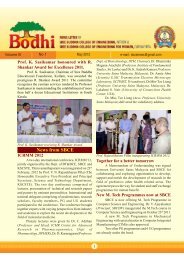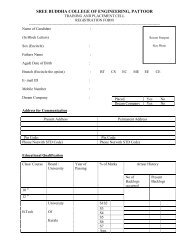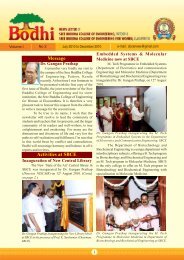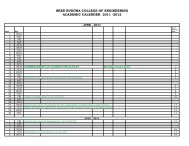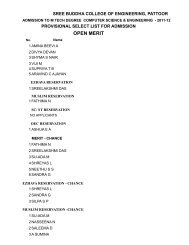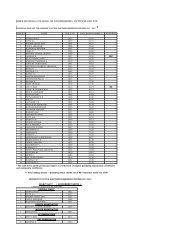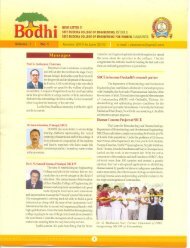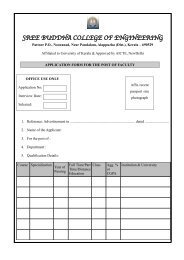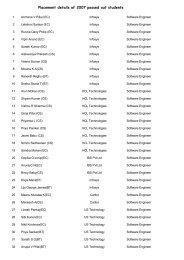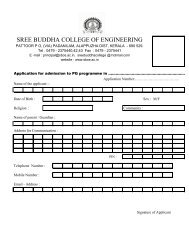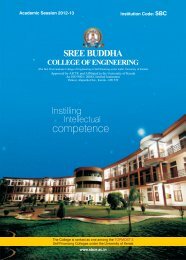UNIVERSITY OF KERALA
UNIVERSITY OF KERALA
UNIVERSITY OF KERALA
You also want an ePaper? Increase the reach of your titles
YUMPU automatically turns print PDFs into web optimized ePapers that Google loves.
properties of fermentation broth, factors affecting broth viscosity (cell concentration, cell morphology, osmotic<br />
pressure, product and substrate concentration).<br />
Measurement of viscosity using extrusion rheometer, plate and cone viscometer, impeller viscometer and coaxial<br />
cylinder rotary viscometer.<br />
MODULE-II<br />
Flow through pipes, average velocity, flow regimes, boundary layer concept. Laminar and turbulent flow –<br />
characterization by Reynold’s number, pressure drop due to skin friction and form friction, friction factor chart, Hagen<br />
-Poiseuille equation. Various equations for friction factor and Reynold’s number for laminar and turbulent flow. -<br />
Moody chart Design of pipeline diameter and flow rate.<br />
Pipes and fittings: Standard pipe sizes, Nominal pipe size, valves, bends, elbows, prevention of leaks, mechanical<br />
seals, stuffing box ( A brief study is only desired).<br />
Fluid transportation machinery: Different types of pumps, positive displacement pumps, reciprocating pumps,<br />
diaphragm pumps, peristaltic pumps ( A brief study is only desired).<br />
Flow past immersed bodies: Definition of drag and drag coefficient, Settling : Flow around a single particle, drag force<br />
and drag coefficient, settling velocity of particles in a fluid, free and hindered settling of particles, thickening by<br />
gravity separation.<br />
Friction in flow through beds of solids: derivation of friction factor equations and pressure drop expressions, flow<br />
though a bed of particles. Packed beds, bed porosity, fluidization and fluidized bed, conditions for fluidization<br />
minimum velocity, types of fluidization. Comparison between packed and fluidized beds.<br />
MODULE –III<br />
Particle Size distribution: Importance of particle size in reactions, particle size, shape and mass distributions,<br />
measurement and analysis, concept of average diameter. Screening:-Screening equipment, capacity and effectiveness of<br />
screen, effect of mesh size on capacity of screen. Particle size analysis:- mean diameter, derived diameter. Sieving -<br />
cumulative method and differential method. Sub-sieve size analysis:- microscopic counting. Pipette analysis,<br />
hydrometer analysis, Photo sedimentation - sedimentation balance, sedimentation and decantation - ICI Sedimentation<br />
Momentum transport by agitation: Power requirements and mixing characteristics of ungassed and gassed systems-<br />
Concept of power number, use of monographs- Defining impeller Reynolds number for Newtonian and non-Newtonian<br />
fluids- Concept of aeration rate to calculate impeller power requirement of gassed systems.<br />
Mixing:- Mixing and bioreaction interactions - Application of mixing in bioprocessing.<br />
REFERENCES<br />
1. D.G.Rao, Introduction to Biochemical Engineering, Tata Mc Hill<br />
2. Pauline M.Doran, Bio-process Engineering Principles, Academic press<br />
3. Mc Cabe, W.L, Smith J.C. and Harriot P, Unit operations of Chemical Engineering, Mc-Graw Hil,<br />
4. Charles, M Technical aspects of the rheological properties of microbial cultures, in Advances in Biochemical<br />
Engineering and Blakebrough, N.(Eds), Spinger-Verlag, Berlin<br />
5. Earle, R.L, Unit operation in Food processing, Pergamon Press, Oxford<br />
The question paper consists of Part A and Part B. Part A is for 40 marks. Part A consists of 10 compulsory short<br />
answer questions each carrying 4 marks covering the entire syllabus.<br />
Part B is for 60 marks. There will be two questions from each module. The candidate has to answer one question of 20<br />
marks from each module.<br />
No charts, tables, codes are permitted in the Examination hall if necessary relevant data is given along with the<br />
question paper by the question paper setter.<br />
24



